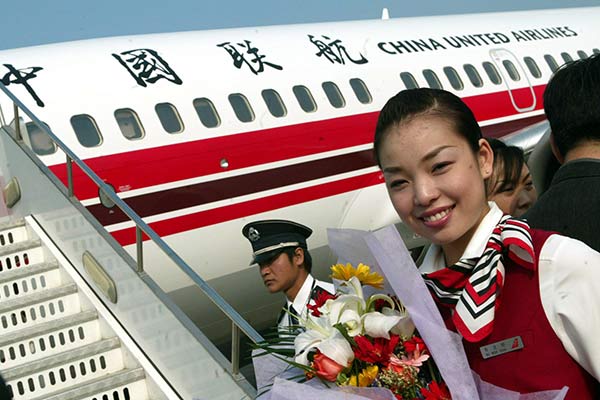 |
|
Bu Wenting, a stewardess of China United Airlines, greets passengers before they board the plane at the Shanghai Hongqiao Airport.[Provided to China Daily] |
As per the employer policy, Xia's colleagues too now fly budget carriers when available. The company's travel costs are down by a fifth.
Many other companies are similarly benefiting by using budget carriers for business travel, which in turn is fuelling fast growth of low-cost airlines.
Since late 2013, the Civil Aviation Administration of China has encouraged budget airlines as Beijing has seen how they have taken off elsewhere. Freeing up new routes for low-cost carriers also helps develop economic growth in western China.
Low-cost carriers account for 7 percent or around 27.5 million of China's domestic air travel market of 392 million passengers. The number of budget airline fliers is expected to more than double by 2020, according to OAG, an aviation data and analytics company.
The overall flier growth is expected to be more than 10 percent in China, the fastest growing major air travel market, according to official data.
Planemaker Airbus predicts China will leapfrog the United States as the world's largest domestic air traffic market within 10 years.
"Low-cost travel has become a life style. Many of my colleagues would start chatting about how to get those 9-yuan ($1.41) or 99-yuan special offer tickets," Xia said.
As Europe's pioneer no-frills airlines such as Ryanair and easyJet mature and move more upmarket, they are attracting business travellers as a way to stand out in the budget crowd.
Compared with full-service carriers, China's four budget airlines offer sharply discounted air fares.
For example, West Air, a subsidiary of Hainan Airlines' parent HNA Group, offers a round trip from Chongqing to the popular southern resort of Sanya and a 3-night stay in a five-star hotel for just 999 yuan, for bookings made well in advance. That compares with 770 yuan for the cheapest one-way ticket offered by full-service carriers, according to Ctrip.com.
In Europe, the cheapest budget airline return ticket for a similar flight, say, from Luton in England to Barcelona in Spain, without accommodation, costs 98 pounds ($148) on cheapflights.co.uk.
All of China's low-cost carriers, except newest entrant 9 Air, are profitable. Much of that is down to severe paring of their costs.
At China United Airlines, flight attendants clean up inside the plane between flights. The airline has squeezed more seats into its fleet of Boeing 737 planes, and turned one of the jets into a flying billboard, advertising Huangguoshu waterfall, China's biggest, said executive vice-president Zhang Lanhai.
With money from the local government, China United passengers are offered big discounts on hotels and tours in the area.
Spring Air took out nearly all the light bulbs on the corridor to Chairman Wang Zhenghua's office, and staff must turn off the lights when they leave for the day. Both the chairman and president eat at the staff cafeteria, and flight attendants share hotel rooms on trips.
The carrier said on Dec 3 it signed a $6.3-billion deal to buy 60 A320neo jets from Airbus to meet rising demand, tap new markets and improve fleet fuel efficiency. Spring Air has halved the size of the kitchen on some existing A320s to accommodate extra seats.
Attracted by the sector's growth potential, some State-backed airlines have converted to low-cost carriers, and others are likely to follow suit.
This year alone, China Eastern Airlines converted its China United unit into a budget carrier, and Juneyao Airlines set up a low-cost subsidiary in Guangzhou.
West Air converted in 2013, and Lucky Air, another HNA carrier, is also going through that transition. China Southern Airlines is also considering setting up a budget subsidiary, executives told Reuters.
The budget carriers have grown in part by flying routes that aren't covered by the bigger airlines.
China United, for example, flies to nearly a dozen cities in Inner Mongolia, more than any other carrier including Air China, which even has a branch there, said Zhang.
Because Inner Mongolia's transport network is still patchy, the quickest way to travel from one city to another is often to fly around 500 kilometers to Beijing with China United and connect there to a flight to the Inner Mongolian destination.
"More and more people are doing this because it's faster and cheaper," said China United's Zhang.
Spring Air, which also flies to popular Asian leisure destinations, started flights in late October to Dongying, an oil-rich city in eastern China whose only connection to Shanghai was previously by a lengthy bus trip and then by high-speed rail. The maiden flight was packed, a company executive said.
Frustrated at not having enough slots at Beijing International Airport, Spring Air offered passengers free high-speed rail tickets to Shijiazhuang airport nearly 300 km away, where it has better slots and offers more flights.
As more Chinese take to the skies, one challenge for the budget airlines is to manage passenger expectations.
Air travel has always been seen as a mode of transport for the privileged in China, and some passengers have been unhappy about meals and leg-room or when asked to pay for luggage or in-flight drinks.
But 9 Air's marketing chief Huang Hui says: "Some passengers who initially complained keep coming back."
